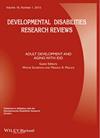Shibani Kanungo, Neelkamal Soares, Miao He, Robert D. Steiner
{"title":"固醇代谢紊乱和神经发育——最新进展","authors":"Shibani Kanungo, Neelkamal Soares, Miao He, Robert D. Steiner","doi":"10.1002/ddrr.1114","DOIUrl":null,"url":null,"abstract":"<p>Cholesterol has numerous quintessential functions in normal cell physiology, as well as in embryonic and postnatal development. It is a major component of cell membranes and myelin, and is a precursor of steroid hormones and bile acids. The development of the blood brain barrier likely around 12–18 weeks of human gestation makes the developing embryonic/fetal brain dependent on endogenous cholesterol synthesis. Known enzyme defects along the cholesterol biosynthetic pathway result in a host of neurodevelopmental and behavioral findings along with CNS structural anomalies. In this article, we review sterol synthesis disorders in the pre- and post-squalene pathway highlighting neurodevelopmental aspects that underlie the clinical presentations and course of Smith-Lemli-Opitz Syndrome (SLOS), mevalonic aciduria (MVA) or the milder version hyper-immunoglobulinemia D and periodic fever syndrome (HIDS), Antley-Bixler syndrome with genital anomalies and disordered steroidogenesis (ABS1), congenital hemidysplasia with icthyosiform nevus and limb defects (CHILD) syndrome, CK syndrome, sterol C4 methyl oxidase (SC4MOL) deficiency, X-linked dominant chondrodysplasia punctata 2(CDPX2)/ Conradi Hunermann syndrome, lathosterolosis and desmosterolosis, We also discuss current controversies and share thoughts on future directions in the field. © 2013 Wiley Periodicals, Inc. Dev Disabil Res Rev 2013;17:197–210.</p>","PeriodicalId":55176,"journal":{"name":"Developmental Disabilities Research Reviews","volume":"17 3","pages":"197-210"},"PeriodicalIF":0.0000,"publicationDate":"2013-06-24","publicationTypes":"Journal Article","fieldsOfStudy":null,"isOpenAccess":false,"openAccessPdf":"https://sci-hub-pdf.com/10.1002/ddrr.1114","citationCount":"76","resultStr":"{\"title\":\"Sterol metabolism disorders and neurodevelopment—an update\",\"authors\":\"Shibani Kanungo, Neelkamal Soares, Miao He, Robert D. Steiner\",\"doi\":\"10.1002/ddrr.1114\",\"DOIUrl\":null,\"url\":null,\"abstract\":\"<p>Cholesterol has numerous quintessential functions in normal cell physiology, as well as in embryonic and postnatal development. It is a major component of cell membranes and myelin, and is a precursor of steroid hormones and bile acids. The development of the blood brain barrier likely around 12–18 weeks of human gestation makes the developing embryonic/fetal brain dependent on endogenous cholesterol synthesis. Known enzyme defects along the cholesterol biosynthetic pathway result in a host of neurodevelopmental and behavioral findings along with CNS structural anomalies. In this article, we review sterol synthesis disorders in the pre- and post-squalene pathway highlighting neurodevelopmental aspects that underlie the clinical presentations and course of Smith-Lemli-Opitz Syndrome (SLOS), mevalonic aciduria (MVA) or the milder version hyper-immunoglobulinemia D and periodic fever syndrome (HIDS), Antley-Bixler syndrome with genital anomalies and disordered steroidogenesis (ABS1), congenital hemidysplasia with icthyosiform nevus and limb defects (CHILD) syndrome, CK syndrome, sterol C4 methyl oxidase (SC4MOL) deficiency, X-linked dominant chondrodysplasia punctata 2(CDPX2)/ Conradi Hunermann syndrome, lathosterolosis and desmosterolosis, We also discuss current controversies and share thoughts on future directions in the field. © 2013 Wiley Periodicals, Inc. Dev Disabil Res Rev 2013;17:197–210.</p>\",\"PeriodicalId\":55176,\"journal\":{\"name\":\"Developmental Disabilities Research Reviews\",\"volume\":\"17 3\",\"pages\":\"197-210\"},\"PeriodicalIF\":0.0000,\"publicationDate\":\"2013-06-24\",\"publicationTypes\":\"Journal Article\",\"fieldsOfStudy\":null,\"isOpenAccess\":false,\"openAccessPdf\":\"https://sci-hub-pdf.com/10.1002/ddrr.1114\",\"citationCount\":\"76\",\"resultStr\":null,\"platform\":\"Semanticscholar\",\"paperid\":null,\"PeriodicalName\":\"Developmental Disabilities Research Reviews\",\"FirstCategoryId\":\"1085\",\"ListUrlMain\":\"https://onlinelibrary.wiley.com/doi/10.1002/ddrr.1114\",\"RegionNum\":0,\"RegionCategory\":null,\"ArticlePicture\":[],\"TitleCN\":null,\"AbstractTextCN\":null,\"PMCID\":null,\"EPubDate\":\"\",\"PubModel\":\"\",\"JCR\":\"\",\"JCRName\":\"\",\"Score\":null,\"Total\":0}","platform":"Semanticscholar","paperid":null,"PeriodicalName":"Developmental Disabilities Research Reviews","FirstCategoryId":"1085","ListUrlMain":"https://onlinelibrary.wiley.com/doi/10.1002/ddrr.1114","RegionNum":0,"RegionCategory":null,"ArticlePicture":[],"TitleCN":null,"AbstractTextCN":null,"PMCID":null,"EPubDate":"","PubModel":"","JCR":"","JCRName":"","Score":null,"Total":0}
引用次数: 76

 求助内容:
求助内容: 应助结果提醒方式:
应助结果提醒方式:


